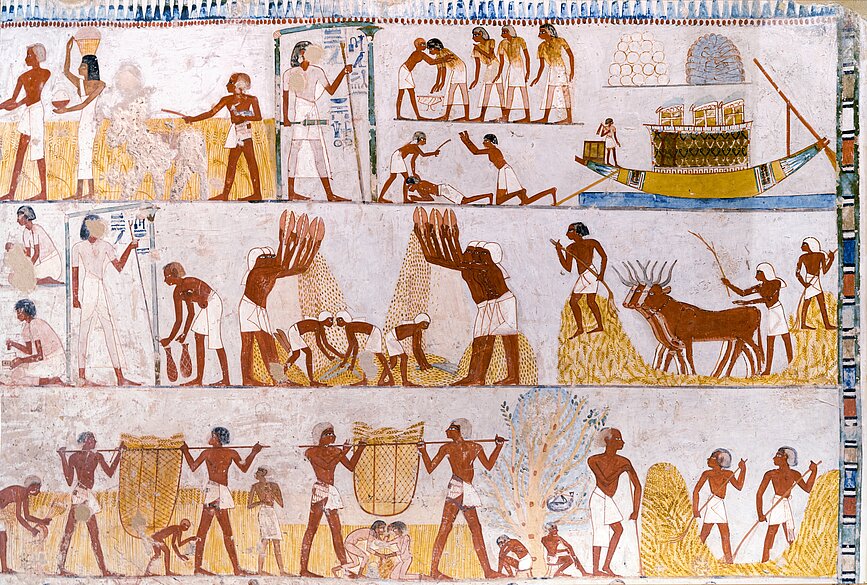What did poverty mean in antiquity? This question will be addressed at an international conference co-organized by Delphine Driaux, FWF Elise-Richter Fellow at the University of Vienna, and Bettina Bader with the Austrian Archaeological Institute at the OeAW. This conference is part of a wider research project entitled »Representations and Reality of Poverty in Ancient Egypt«, directed by Delphine Driaux. She is working on the poor, who constituted a large part of Egyptian society and yet remained in the shadow of the elite and their prestigious and beautiful objects and monuments. The aim of this conference is to shed light on these people, who have been ignored by researchers for too long. It will be an opportunity to discuss the problems of defining poverty in Antiquity and the methods used to study this phenomenon, but also to try to better understand who these people were, how they lived and how they were regarded by their contemporaries. The keynote lecture will be given by Margaret Maitland, Principal Curator of the Ancient Mediterranean at National Museums Scotland, who gives an insight into poverty in Ancient Egypt from the view point of Egyptian social elite. She gives a brief overview of her research in the following interview.
What are some of the questions you are planning to discuss in your keynote lecture?
Maitland: It is obviously a huge topic to tackle and one that is difficult to define because poverty is always relative. So different individuals will have different definitions on how they view poverty. I really want to look at the various ways in which people’s lives could be impoverished beyond just economic factors to really see how the impacts of stigmatisation and the different sort of ways in which elite attitudes towards labourers and how they treated them will have curtailed the opportunities that would have been available to a large part of ancient Egyptian society, contributing to creating a highly unequal society.
The ruler as divine source of power
How important was class in ancient Egypt?
Maitland: There was the king, the ruler of Egypt, who was the ultimate source of power and control, who was presented as having a divine source of power. He acts through his elite officials and they themselves have subordinates who support them, down to the scribes who are responsible for writing and documenting, which was a really important means of control. It's a very agricultural based society, so you have many different occupations involved in farming, but also other forms of food and craft production. The elite themselves function as observers, as authority figures, so they're able to separate themselves from these positions of physical labour. Stigmatisation was used to portray social differences in a negative manner, and these were used in processes of shaming, for example through public presentations of physical punishment. The Egyptian elite saw them as educational opportunities that were wholly justified and were used to maintain social order.
Elite visual and textual culture can give us insights into the social constructs and stigmatisation that made poverty seem inevitable.
Do we have any direct evidence of those who were considered poor?
Maitland: That's where archaeology can fill in some of the gaps. Our colleagues have been excavating settlement sites where you can see the spaces in which the non-elite would have lived, as well as the graves of non-elite people. At the site of Amarna there's huge evidence of the physical toll that a life of hard labour and limited nutrition would have had on the bodies of the people. Also, economic texts can help and inform our understanding of wages, costs, and how people would have lived. I think it’s important to consider not just who was poor, but how that poverty was created. Elite visual and textual culture can give us insights into the social constructs and stigmatization that made poverty seem inevitable, glimpses into the suffering that people at the lowest economic levels of society would have endured, and how they may have resisted.
Shame and Stigmatisation
How can we understand inequality in ancient Egypt and how can we also make sure that we are not projecting our modern understanding of equality or inequality on those past societies?
Maitland: There are some people who might say that even conceiving of inequality in ancient Egypt is ahistorical. But we also have to remember that the only clear views that we have represented are elite views. So I think it's also misleading to represent those as the only views that were present in ancient Egypt. We can't directly access the thoughts and feelings of the majority of ancient Egyptian society, but it's still very clear that many people would have been subjected to stigmatisation and shaming.
Can you give an example?
Maitland: There’s a poem called “The Tale of the Eloquent Peasant” which subverts some of those ideas in showing a peasant who is actually wise beyond his position. But even then, his willingness to stand up for himself against injustice is portrayed as potentially problematic and threatening to the social order. Literary texts would have been probably performed orally, but also read by the very few people who were literate as well. These would have been mainly directed towards elite audiences, but they give us glimpses as to how they justified and legitimised inequality.
